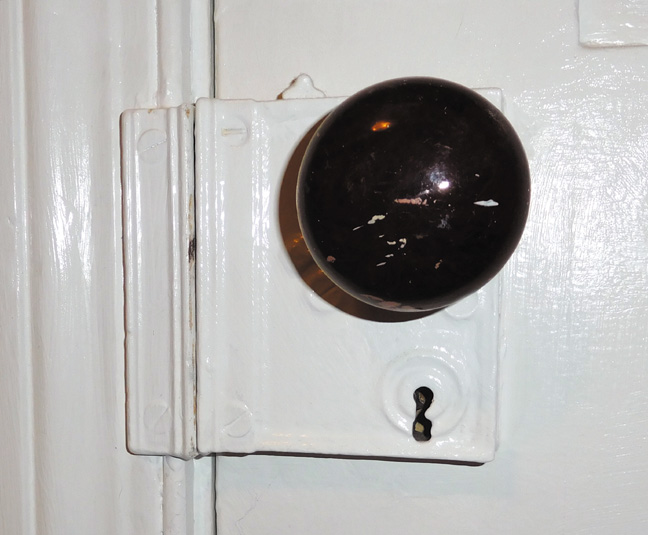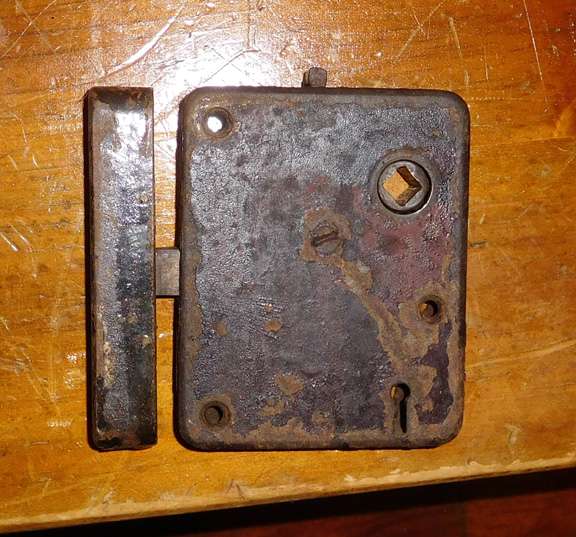Cast Iron Rim Locks
Seth Hinshaw, 1/5/2019
A ubiquituous element in late nineteenth century houses is the cast iron rim lock. Little has been written about the history of this piece of door hardware, which is rather remarkable. Its history is closely associated with the porcelain knob, as the two items emerged about the same time and fell from production at the same time as well.

The cast iron rim lock is a successor to the larger rim locks found in the early nineteenth century. These earlier rim locks were larger than the cast iron rim lock and were called "box locks" at the time.
John P. Sherwood of Sandy Hill, New York, patented a door lock in 1842 (Patent #2,886) consisting of a cast iron case that could be installed with either main face outward. Prior to this time, rim locks were designed specifically for left hand doors or right hand doors, with an open face along the door surface. Sherwood's lock would operate on either type of door. This lock later came to be called the "Janus lock" since it faced both directions. Sherwood extended his patent in 1851, granting him exclusive rights to production of the lock until 1864.
While Sherwood's exclusive rights were intact, other advances in door locks were initially based on the older style of rim ("box") locks. One of the final patents in that series was Patent #9,265 (1852) by William Moore, which offered a cast iron rim lock that was smaller in depth than the earlier rim locks (the "box locks") but of similar face dimensions. In 1857, Calvin Adams of Oak Hill, New York, obtained Patent #16,676 for improved keepers for a cast iron rim lock. His patent illustration shows a "Janus" lock operating with his improved keepers. Subsequent patents for rim locks relate to the cast iron rim lock (still then called the "Janus lock") for several decades. Apart from the early cast iron rim lock produced by Sherwood in the 1840s, the earliest cast iron rim locks were produced circa 1857 and afterwards.
Early cast iron rim locks (1860s) share some characteristics. The standard size was 3.25 by 4 inches, a size that was retained throughout its years of production. The Sherwood lock was designed to be installed horizontally. Most of the early rim locks that I am familiar with were also horizontal, but patents for competitors usually show the lock vertical as a means of helping them stand out. As the century progressed, rim locks were more frequently vertical than horizontal. Producers of rim locks began to add their name onto the exterior of the lock beginning around 1870. Another change found among rim locks of the 1890s is that they were installed upside down, with the keyhole at the top.
In the 1850s, the porcelain knob came into heavy production. This innovative element was attached onto a metal spindle with a square shaft slightly wider than 1/4 inch, the standard size to operate cast iron rim locks. Eventually, the rim lock and the porcelain knobs were assembled for distribution rather than always being sold separately.

The rim lock shown here (without its porcelain knobs) is interesting because the corners are rounded. It has no identifying marks of its manufacturer, so I am not sure when it was produced. It was located in a house that was enlarged in 1850, but I believe the lock dates to circa 1880.
The popularity of cast iron rim locks shifted around 1880. As veneered doors became more popular, it quickly became obvious that they were not overly compatible with cast iron rim locks. Early veneered doors were not as durable as those of today due to lower quality glues then in use and a poor understanding of seasoning of the interior wood elements of the door. The problem was that the screws that held the lock onto the door broke through the veneer in an often unsightly manner and sometimes disrupted the interior pieces of wood in the door, sometimes rendering the door unusable or hard to close. Producers of veneered doors quickly amended their production processes to accommodate mortise locks instead, bypassing the need for rim locks.
Cast iron rim locks began a long decline in popularity by 1890. Among new construction, they remained in use for private portions of high style houses and remained initially common in middle class houses. By the early twentieth century, the market faced a glut of rim locks and porcelain knobs. Both became standard hardware for kit houses as a means of reducing the existing inventory of these formerly popular items in warehouses. They both apparently went out of production around the time of World War I.
Earlier blog posts
8/28/2020 Chicago Millwork Supply Company catalog of 1931
10/6/2019 History of Hinkle & Company (1833-1870)
9/17/2019 History of Mulliner Box & Planing Company
6/3/2019 J.R. Quigley Plant, Gloucester City, New Jersey
4/23/2019 Cleveland Cottage Door
4/13/2019 Trenton historic door #2
4/10/2019 Trenton Doors #1
3/6/2019 Pressed Wood Door Knobs
2/23/2019 Gettysburg Doorscape, Part 4
2/18/2019 Gettysburg Doorscape, Part 3
2/12/2019 Gettysburg Doorscape, Part 2
2/9/2019 An Introduction to the Gettysburg Doorscape
1/22/2019 The Blake Latch
1/19/2019 Rare Four-Panel Door of 1890s
1/5/2019 Cast Iron Rim Locks
12/28/2018 Inaugural Blog Post